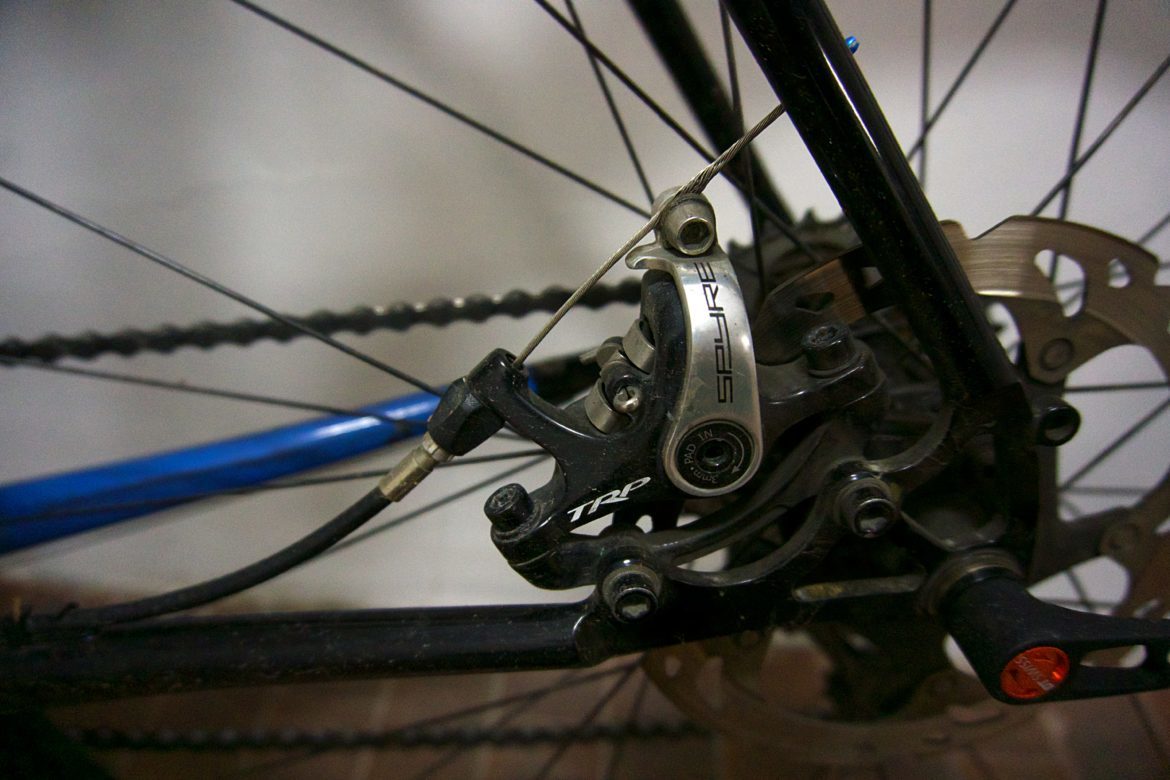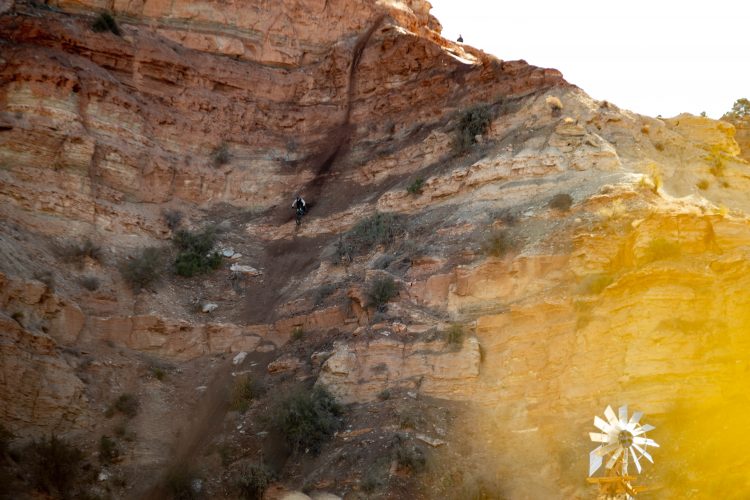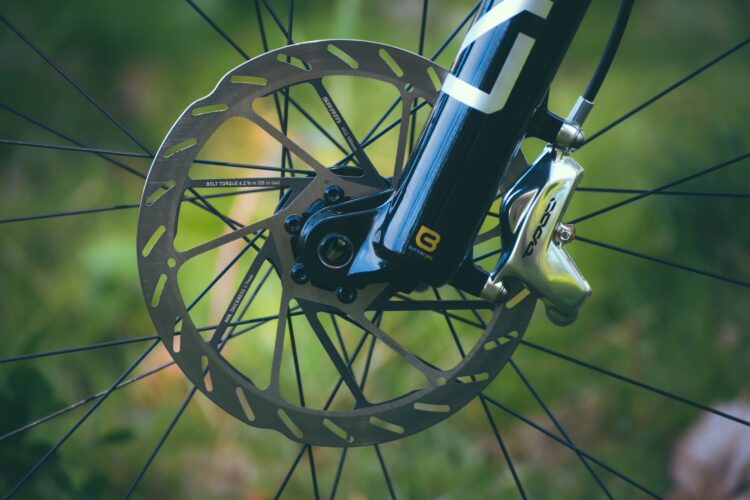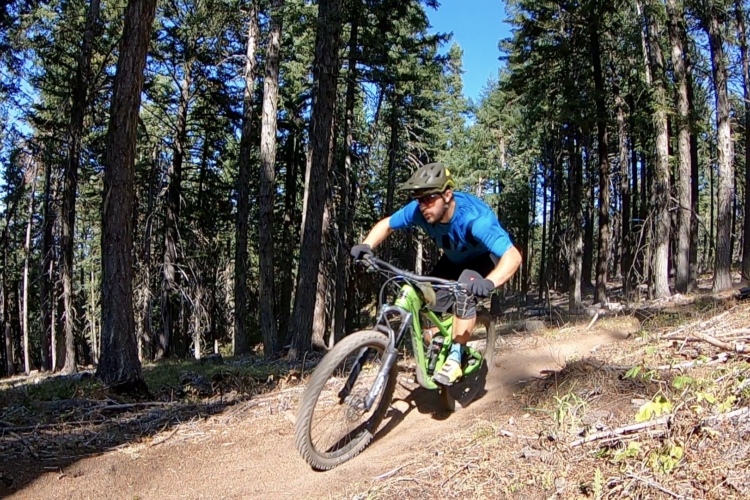
Choosing the best brakes for your mountain bike is a piece of cake–if you know what to look for. If you’re in the market to upgrade your bike’s stoppers, this guide should dial you in to what’s important. We cover some basic knowledge and what to know when shopping for a new set of mountain bike brakes, and our picks for the best gravity, trail, and XC hydraulic mountain bike brakes on the market.
The best mountain bike disc brakes in 2025
Singletracks has tested dozens of mountain bike brake sets over the years, including all of the most popular models. Here are a few recommended MTB disc brake systems to consider.
- Best mountain bike brakes: TRP DHR-EVO
- Best budget brakes: Shimano MT520
- Lightest MTB brakes tested: Trickstuff Piccola 2-piston
- High power brakes: SRAM Maven and Hope Tech 4 V4
- Excellent modulation: Formula Cura 4
Tell us which brake set is your favorite using the survey form below. Results are shown after your submit your vote.
Readers’ choice
- Best brakes 2024: Shimano XT

The best brakes for enduro, downhill, and freeride
Hope Tech 4 V4
- Weight: 310g per side, uncut hoses
- Fluid: DOT 5.1
- Pistons: 4
- Price: $265-300 per side
- Buy from Backcountry and JensonUSA
The excellent modulation the Hope Tech 4s offer and the minimal effort they require make controlling a big bike on big terrain as easy as possible, letting you focus on the ride instead of trying not to crash. Read Michael’s complete Hope Tech 4 V4 brake review.
What we like: gobs of power; highly adjustable; rebuildable.
What we don’t like: messy bleed process.

Shimano Saint M820
- Weight: 450g each
- Fluid: Shimano mineral oil
- Pistons: 4
- Price: $240 each
- Available at Jenson USA and other online retailers
Bombproof, tried and true, the Saint has been around for more than ten years. They are known for their reliability, strength, and resistance to fade on the longest of downhills. If you’re a heavier or faster rider who wants reliable power over anything else, these are a great choice. Read the full review of the Shimano Saint brakes.

SRAM Maven
- Weight: 362g (claimed, rear)
- Fluid: Mineral oil
- Pistons: 4
- Price: $299 (each), rotors not included
- Buy from Worldwide Cyclery
If you’re an aggressive rider who demands maximum performance and power from your brakes, then you need to hop on a bike equipped with SRAM Mavens. Once you’ve sampled their revolutionary stopping prowess, there’s no way you’ll be able to go back to the brakes you were running before. However, if you’re an endurance or XC rider and weight is a significant factor for you, you may need to look elsewhere. Read the full SRAM Maven review.

TRP DHR-EVO
- Weight: 328g each
- Fluid: TRP mineral oil
- Pistons: 4
- Price: from $270 each
- Buy from REI
The TRP DHR-EVO has been one of the most popular enduro and downhill brakes since its debut. The DRH-EVOs use TRP mineral oil, have beefy master cylinders and levers, and can stop a lot of weight for a long time without requiring maintenance. Read the full review of the TRP DHR-EVO brakes.

Formula Cura 4
- Weight: 379g each
- Fluid: Mineral oil
- Pistons: 4
- Price: $208 each
- Buy from Jenson USA
Formula doesn’t do entry-level, but if you’re willing to spend a little bit of money, you’re in for a treat. The Cura 4s have excellent modulation with a light and responsive lever action and it’s easy to find the perfect amount of force. These brakes use a proprietary mineral oil for long-lasting performance, though some might find they don’t have the adjustment capabilities of some other brakes. Read the full review of the Formula Cura 4 brakes.

Trickstuff Direttissima
- Weight: ~221g each
- Fluid: Trickstuff mineral oiil
- Pistons: 4
- Price: €450 each
Trickstuff’s 4-piston Direttissima brakes–Italian for “very direct” have a smooth, light lever feel and power by the buckets. And not only do they have power, they offer modulation for just the right amount of pressure. Bleeding these brakes takes some patience, but it can be easily done by the avid home mechanic and they use a Trickstuff mineral oil. These are also some of the lightest gravity brakes on the market. The two downsides of these brakes are that they are pricey and hard to get in the U.S. Otherwise, the Direttissimas are a stunningly good-looking brake with performance to match. Read the full review of the Trickstuff Direttissima brakes.

The best trail bike brakes
Shimano SLX/XT/XTR
- Weight: 445g (SLX), 410g (XT), 375g (XTR)
- Fluid: Shimano mineral oil
- Pistons: 4
- Price: from $187 each
- Buy from Jenson USA
Shimano’s lineup of 4-piston brakes is probably the most versatile on the market. You’ll see them on downcountry, trail, and enduro bikes alike. They’re reliable and look sharp and deliver a commendable amount of power in their package. We’ve reviewed the full line: Shimano SLX BR-M7120 brakes, Shimano XT BR-M8120 brakes, and Shimano XTR BR-M9120 brakes.

TRP Slate Evo
TRP takes the technology that made their DHR-Evo brakes great and put them in a more affordable package with a simpler finish. The end result: Great braking power for trail brakes and a really nice price. These Slate Evos can last a long time without a bleed making them a great choice for those who want a premium feeling brake without the hassle of maintenance. Read the full review of the TRP Slate EVO.

Magura MT5
- Weight: 255g
- Fluid: Magura Royal Blood mineral oil
- Pistons: 4
- Price: $119 each
- Buy from REI
Magura’s MT5 brakes feature much of the same great modulation, power and reliability as the Magura MT7 brakes, but with a simpler master cylinder and a better price. These make for a great all-around trail bike brake.

Hayes Dominion T4
- Weight: 257g
- Fluid: DOT 4 or 5.1
- Pistons: 4
- Price: $325 each
- Buy from REI
The Hayes Dominion T4 are a lighter weight version of their A4 brakes, complete with carbon levers and titanium hardware. The Dominion T4s have a short stroke and a progressive bite and two bleed ports at the caliper to make removing air easier and more efficient. Read the full review of Hayes Dominion T4 brakes.

The best cross-country bike brakes
Trickstuff Piccola 2-piston
- Weight: 150g each
- Fluid: Trickstuff mineral oil
- Pistons: 2
- Price: €450
The Trickstuff Piccola 2-piston brakes were some of the most powerful and snazziest cross-country brakes we’ve tested. The Piccolas are light for serious XC riders but match the stopping power of heavier brakes and have a reputation for longevity. Unfortunately these can be hard to find in the U.S. Read the full review of Trickstuff Piccola 2-piston brakes.

Hope Tech 4 X2
- Weight: NA
- Fluid: DOT 5.1
- Pistons: 2
- Price: $220 each
- Buy from Jenson USA
Hope’s X2 brakes use the same Tech 4 lever as their stronger E4 and V4 brakes, but it’s paired with a sharp 2-piston caliper instead for a lighter weight. The X2 brakes comes in a handful of anodized color options for a perfect match.

The best budget mountain bike brakes
Shimano BR-MT520
- Weight: NA
- Fluid: Shimano mineral oil
- Pistons: 4
- Price: $74 Front / $138 Rear
- Buy from Amazon
E-bikes have helped bring some strong technology to market since their debut and the Shimano MT520 brakes are a great example. The brakes have ceramic pistons, Servo-wave and I-spec II compatibility just like other Shimano brakes, but in a very affordable package. They of course skip on a lot of features that pricier brakes get, like tool-less reach adjust and a slick finish, but for the price they are hard to beat.
Understanding mountain bike brakes
There’s a lot to know about mountain bike brakes, starting with the basic types and how brakes work. The following buyers guide will help you get familiar with brakes so you can choose the best option for your bike and style of riding.
Mountain bike brake types
Most modern mountain bikes these days come with disc brakes and on most of those, you’ll see a hydraulic brake system with either 2- or 4-pistons.
For lighter cross-country and some trail bikes, 2-piston calipers tend to work well. They don’t have as much stopping power as a 4-piston brake, but they are usually lighter.
On some trail, and most all-mountain, enduro, and downhill bikes, you’ll find 4-piston disc brakes. These systems have more power than 2-piston calipers but are heavier. Since riders are generally going faster on these bikes, stopping power is often preferred over the weight penalty.

Hydraulic vs. Mechanical Disc Brakes
Disc brakes can operate both hydraulically and mechanically. Hydraulic brakes utilize a piston-cylinder system filled with fluid similar to the brakes you’d find on a motorcycle or car. Most modern mountain bikes these days have hydraulic brakes, but on entry-level bikes, some manufacturers still spec mechanical disc brakes.
Mechanical brakes use a steel cable to translate a pull on the brake lever into a pull on the caliper at the disc.
Hydraulic brakes use hydraulic power, a plunger in the master cylinder and pistons inside the caliper to actuate the brakes.
Mechanical brakes are less expensive and riders may find them easier to maintain and troubleshoot, though even cables stretch and need to be replaced. Both mechanical and hydraulic mountain bike disc brakes require maintenance.
Because most modern mountain bikes have hydraulic disc brakes, we’ll focus on their technology and use them as a reference.
Rotor Considerations

The rotor in a disc brake system is the circular disc mounted to the wheel that the brake pads inside the caliper grabs to slow the bike down. One of the rotor’s main jobs is to dissipate heat caused by braking so manufacturers often use innovative patterns and materials that seek to maximize airflow and heat transfer (while keeping weight low). A rotor’s diameter also dictates heat transfer.
Again, weight and stopping power determine the size of brake rotors on cross-country and trail bikes versus gravity bikes made for enduro or downhill.
These days, there aren’t many 160mm rotors out there, except for dedicated cross-country race bikes. Most trail bikes have moved toward 180mm rotors and gravity bikes and e-bikes use 200mm rotors and sometimes 220mm rotors–helpful for stopping heavier bikes.
To some degree, the position of the caliper mounts on a bike frame or a fork dictate the size of the rotor that can be used, but adapters make it possible to mount larger rotors.
Rotor thickness used to be standardized to 1.8mm, but now some brands like TRP (pictured above) and SRAM have developed 2.3mm thick rotors. These rotors are said to add a stiffer overall braking feel and manage heat better.

Brake fluid considerations
Amongst hydraulic disc brakes, you’ll find two choices for brake fluid and die hards on either side: mineral oil or DOT 5.1.
Some brands like SRAM, Hope, and Hayes use DOT 5.1 and others like Shimano, TRP, and Magura use mineral oil.
There is merit behind both and they each have their advantages. Mineral oil tends to last longer without maintenance, flushes or bleeds, but properties between different brands can differ a lot since it is not regulated by the DOT.
DOT 5.1 is regulated and different fluids are usually more consistent between any two. DOT 5.1 is hygroscopic though and will absorb water, decreasing performance. Because of this, brakes with DOT 5.1 usually need to be bled and flushed more than brakes with mineral oil. Shelf life of open DOT 5.1 containers is short too.
There really is no clear winner between the two fluids and there are outstanding mountain bike brakes from brands that use mineral oil and DOT 5.1 fluid.

Disc Brake Pads
There are three basic types of disc brake pads for mountain bikes: semi-metallic, sintered, and organic.
Semi-metallic brake pads are known to produce better stopping power and they don’t wear as quickly as organic pads. Out of the box, most brakes will include some type of semi-metallic brake pad.
Sintered pads are also known as metallic pads and are typically used by gravity riders due to their high friction values. In fact, sintered pads generate more friction at higher temperatures than low so they don’t have as much initial bite as organics but work well in extreme conditions.
Organic brake pads (also called resin) offer improved modulation because of the softer material and generate less noise. But remember, they also tend to wear out more quickly and you’ll want to avoid them for wet rides.
Ceramic disc brake pads are also available and in general they’re similar to metallic pads but with improved heat performance.

Brake Modulation
Brake modulation refers to the way stopping power is affected by the position of the brake lever. For example, a system with high modulation generates a little stopping power for a light pull on the lever, medium power for a medium pull, and so on. A brake system with low (or poor) modulation might instantly jump from low stopping power to full stop with just a minor change in lever pressure.
Mid- to high-end braking systems may feature reach, stroke, and even modulation adjustments. A reach adjustment allows the rider to change the distance from the brake lever to the handlebar, perfect for riders with smaller hands. Stroke adjustment affects the amount of “play” in the brake lever; some riders prefer a long stroke while others prefer a short stroke. Each of these adjustments affects modulation to some degree and in addition to these adjustments, some systems allow the rider to change the ratio of the lever piston to the caliper piston for even greater modulation control.

Choosing a mountain bike disc brake
Armed with an understanding of the basics, it’s time to choose a disc brake system. Manufacturers typically package brake systems based on the type of riding you’ll be doing. Beyond riding style, heavier riders, for example, may want to go with a system with a little extra stopping power even if they intend to stick to mostly XC trails.





















5 Comments
Feb 9, 2013
Jan 16, 2017
Feb 8, 2013
Cheers
Barry
Feb 8, 2013
Feb 8, 2013